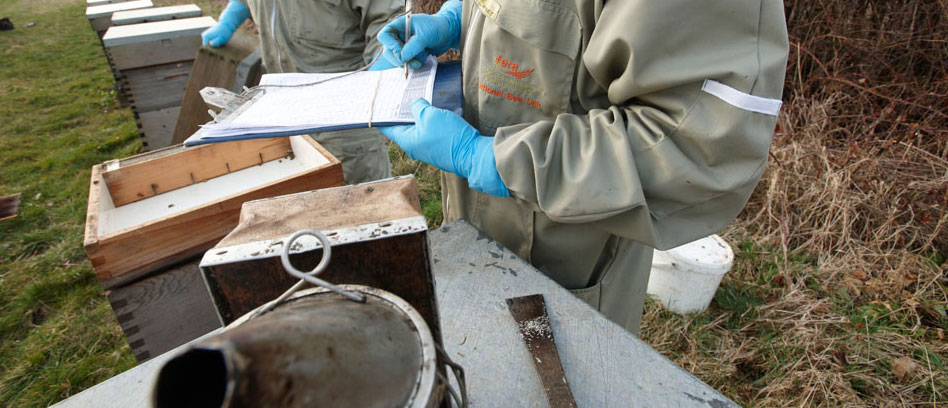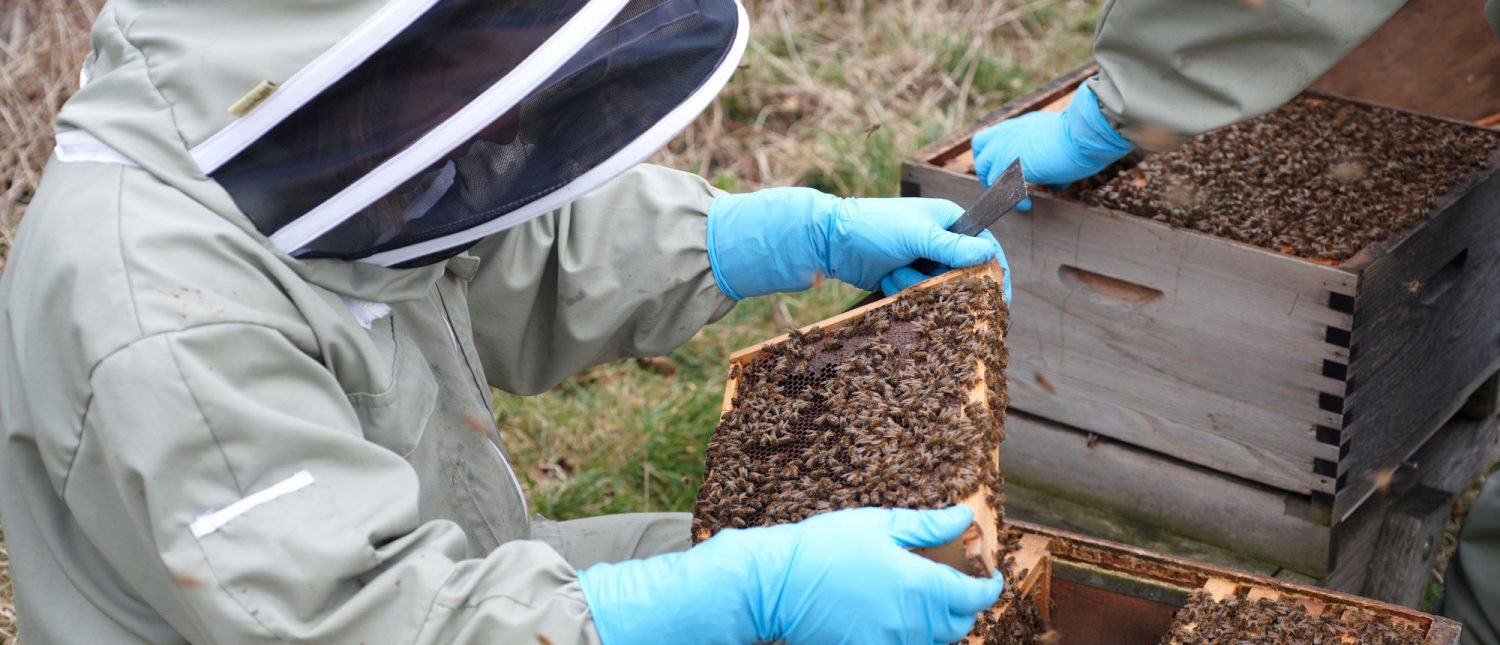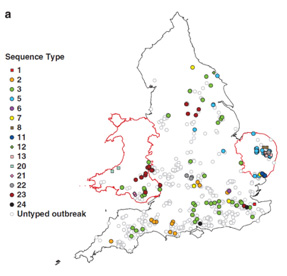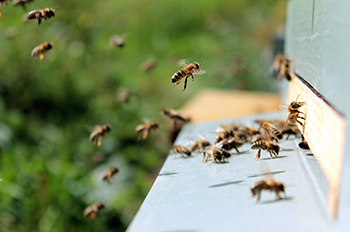
Visit our other sites
-
Fapas - Proficiency Testing
Globally recognised provider of proficiency tests, running over 400 tests annually across an extensive range of matrices and analytes
-
Great Crested Newts Testing
A single sample taken by an ecologist at any time during the newt breeding season can determine their presence or absence, saving you time and money
Diagnostic expertise spanning a wide range of honey bee pests and diseases

With a wide range of expertise in the diagnosis of honey bee pests and diseases and our work in preserving the future of our pollinators, Fera are the perfect partner for your diagnostic and research requirements.
Our range of services is underpinned by our extensive knowledge of honey bee biology and behaviour of global relevance, including analysis undertaken for new and emerging pests and diseases. Our scientists also sit on national and international panels to provide expert evidence and support to policy makers.

Services include: diagnostic methods, assessment of control methods, epidemiological studies and bespoke research and development projects.
Fera’s diagnostic services, advice and interpretation of results in honey bee health, continually meets the needs of government and beekeepers. Our diagnostic expertise spans a wide range of honey bee pests and diseases, including statutory notifiable diseases such as European and American foulbrood, a range of viral diseases, and pests and diseases that affect the health of adult honey bees such as Nosema infection and infestation with parasitic mites, as well as providing screening for possible exotic threats that could potentially arrive in the UK.
Fera are required to diagnose a variety of pests and diseases faced by beekeepers within rapid turnaround times, allowing government agencies to carry out the honey bee inspection programme. In a typical year, we provide results for 800-1000 samples on a variety of samples, screening for invasive species and statutory notifiable pests and diseases potentially encountered by beekeepers. We work with beekeepers and government to identify issues with both a targeted approach, looking for specific organisms within a sample, and non-targeted approaches, which allows us to identify all organisms present in a sample, to gain a comprehensive understanding of colony health, as well as identify potential new threats or beneficial organisms for honey bee health. Our expertise includes entomologists, molecular biologists, beekeepers and scientists trained in disease recognition, enabling us to provide the diagnostic services that governments require in order to carry out the inspection activities of the National Bee Unit.
Our capabilities range from traditional microscopic and visual identification of pests and diseases to molecular identification techniques. This access to a wide range of expertise allows us to respond in a rapid and flexible fashion to government needs.
For example, when conventional methods, such as morphological identification are not possible, we can apply molecular diagnostics, and we can apply these techniques during both routine monitoring, and in non- routine outbreak scenarios, answering government requests for information on pests and diseases, such as providing detailed information on particular strains of disease, and providing information of the genetic origin of potentially invasive pests.
In addition, we able develop new diagnostic methods, from conception to routine laboratory use, such as in field testing techniques that use LAMP (Loop-Mediated Amplification) technology.
Diagnostic methods
- Traditional (Visual assessment /slides/ taxonomy)
- Molecular methods including next generation sequencing for assessment of causal agents
- Development of methods suitable for field use
- Methods providing quantitative as well as qualitative results
- Species include invasive/quarantine pests and diseases as well as those endemic to the UK/Europe
- Methods for detection and monitoring of pest species (development of traps/lures) and assessment of implementation
Control methods
- Assessment of new compounds and formulations
- Development of novel control methods
Epidemiological studies
-
Evaluation of the potential spread and methods of transmission
Research and Development
Policy advice and support
Preserving the future of our pollinators. Working together with government, research institutes and universities on pollinator health.
With a wide range of expertise in the diagnosis of honey bee pests and diseases and our work in preserving the future of our pollinators, Fera are the perfect partner for your diagnostic and research requirements.
Our range of services is underpinned by our extensive knowledge of honey bee biology and behaviour of global relevance, including analysis undertaken for new and emerging pests and diseases.
While our highly skilled research scientists consists of experienced research personnel across many disciplines, including Molecular and cellular biology, Virology, Ecotoxocology, Entomology, Economics and Statistics.
We also sit on national and international panels to provide expert evidence and support to policy makers.
Case Studies

Epidemiology and Genomics of European Foulbrood (Melissococcus plutonius) of Honey Bees
Funding
-
The Insect Pollinators Initiative
-
Biotechnology & Biological Sciences Research Council (BBSRC)
Academic partners
-
University of York
-
University of Bath
People
Dr Edward G. Haynes, Dr Giles Budge, Dr Thorunn Helgason, Dr. J.P.W. Young and Dr Richard Thwaites
Dates
October 2009 to September 2013
The challenge:
European foulbrood (EFB) is a serious bacterial disease of honeybee brood caused by Melissococcus plutonius. It is found throughout the UK and can persist in honeybee colonies in the absence of symptoms. When symptomatic, it is lethal to honeybee brood and can result in the loss of colonies. Regional and seasonal differences in prevalence are often observed and sporadic outbreaks may occur. In the past decade, the incidence of EFB infection has been increasing in the UK and in Switzerland. The cause is unknown as the epidemiology of the disease is poorly understood.
Our approach:
Next generation sequencing was used to identify high polymorphic regions of the genome of Melissococcus plutonius. These regions were used to create a sequencing typing scheme using multi-locus sequence typing (MLST), a powerful molecular method for differentiating between different strains of pathogens. MLST uses sequence variation in a number of genes to compare different strains or sequence types for a pathogen. For this scheme, four loci were identified that had sufficient allelic diversity between strains to differentiate between different EFB isolates.Development of an MLST scheme for EFB allows the epidemiology of the disease to be investigated. The scheme was applied to 206 isolates of EFB obtained across England and Wales over 2 years in an attempt to understand the regional or seasonal differences in EFB. It was also used to look at EFB internationally.
Communication:
Collaborators on this 3 year project met at 6 monthly project meetings.
This work also resulted in two peer-reviewed papers:
Haynes E., Helgason T., Young J.P.W., Thwaites R. and G.E. Budge. (2013) A typing scheme for the honeybee pathogen Melissococcus plutonius allows detection of disease transmission events and a study of the distribution of variants. Environmental Microbiology Reports. 5. 525-529.
Budge G.E., Shirley M.D.F., Jones B., Quill E., Tomkies V., Feil E.J., Brown M.A. and E.G. Haynes. (2014) Molecular epidemiology and population structure of the honey bee brood pathogen Melissococcus plutonius. The ISME Journal. 8. 1588-1597.
Results:
This work resulted in the generation a draft genome sequence for EFB/ Melissococcus plutonius. This work identified at least 15 different strain types of EFB in the UK and has allowed for analysis of disease dynamics (see figure a). In a number of examples, this information has been used to track the source of a new outbreak of EFB in one area of the UK as coming from another specific region in the UK (often identified as being caused by the sale of infected material between beekeepers). In another example, this information was used to identify a new EFB infection in the UK and identified the potential source as an import from another EU country. This data has also suggested that certain strain types are more virulent than others, which may in future be used to direct a more stringent disease management policy.
This work has also led to the development of an active database of different strain types of the bacterium called pubmlst: http://pubmlst.org/mplutonius/. This is a database where sequence types of EFB can be deposited. There are many contributors to this database and this allows for the prevalence of sequence types to be observed on an international level.

Unique research:
This research has resulted in a scheme at FERA called the MLST scheme. FERA has been sequencing typing all EFB samples submitted to by our colleagues at APHA (the bee inspectors) for the past 5 years. This allows us to continue collecting information in the long term on EFB strain epidemiology.

Our track record for obtaining funding is excellent and includes many high profile pollinator projects such as SmartBees, the Insect pollinators initiative and EPILOBEE.
We are also in a unique position of working alongside with the Bee farmers association and the British beekeepers association.
Speak to us now about your pollinator research project.
IN THIS SECTION

Bee Ecotoxicology
Our research expertise and scientific resources can help you to test your plant-protection products for their effects on bee survival, development and behaviour – helping you to develop products that are safe for bees and other pollinators.

Copyright © 2025 Fera Science Limited (“Fera”). All rights reserved.
For further information about how Fera uses any personal data collected from you, please see our Privacy Notice at www.fera.co.uk/privacy-policy.

